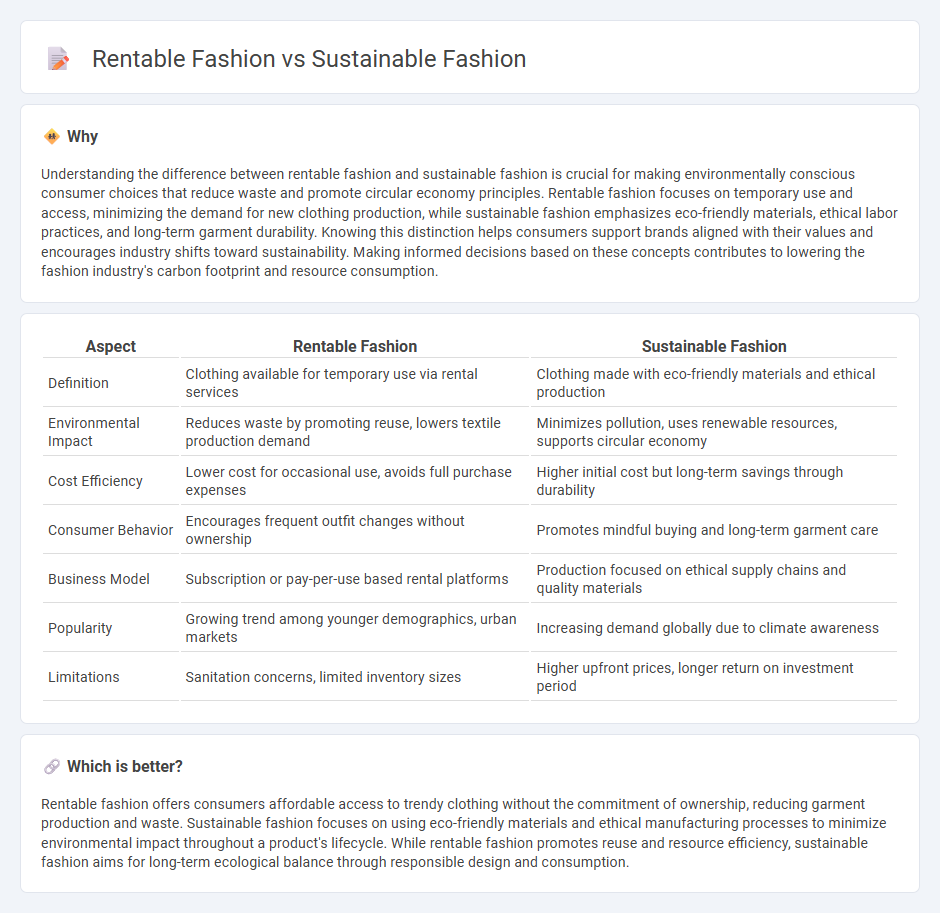
Rentable fashion offers consumers temporary access to trendy clothing, reducing waste by promoting reuse and lowering the demand for new garment production. Sustainable fashion prioritizes environmentally friendly materials, ethical labor practices, and long-lasting designs to minimize the industry's ecological footprint. Explore how these models transform the future of commerce by balancing style, responsibility, and consumer behavior.
Why it is important
Understanding the difference between rentable fashion and sustainable fashion is crucial for making environmentally conscious consumer choices that reduce waste and promote circular economy principles. Rentable fashion focuses on temporary use and access, minimizing the demand for new clothing production, while sustainable fashion emphasizes eco-friendly materials, ethical labor practices, and long-term garment durability. Knowing this distinction helps consumers support brands aligned with their values and encourages industry shifts toward sustainability. Making informed decisions based on these concepts contributes to lowering the fashion industry's carbon footprint and resource consumption.
Comparison Table
| Aspect | Rentable Fashion | Sustainable Fashion |
|---|---|---|
| Definition | Clothing available for temporary use via rental services | Clothing made with eco-friendly materials and ethical production |
| Environmental Impact | Reduces waste by promoting reuse, lowers textile production demand | Minimizes pollution, uses renewable resources, supports circular economy |
| Cost Efficiency | Lower cost for occasional use, avoids full purchase expenses | Higher initial cost but long-term savings through durability |
| Consumer Behavior | Encourages frequent outfit changes without ownership | Promotes mindful buying and long-term garment care |
| Business Model | Subscription or pay-per-use based rental platforms | Production focused on ethical supply chains and quality materials |
| Popularity | Growing trend among younger demographics, urban markets | Increasing demand globally due to climate awareness |
| Limitations | Sanitation concerns, limited inventory sizes | Higher upfront prices, longer return on investment period |
Which is better?
Rentable fashion offers consumers affordable access to trendy clothing without the commitment of ownership, reducing garment production and waste. Sustainable fashion focuses on using eco-friendly materials and ethical manufacturing processes to minimize environmental impact throughout a product's lifecycle. While rentable fashion promotes reuse and resource efficiency, sustainable fashion aims for long-term ecological balance through responsible design and consumption.
Connection
Rentable fashion reduces environmental impact by promoting reuse and minimizing waste, aligning closely with sustainable fashion principles focused on eco-friendly production and consumption. Both concepts emphasize extending the lifecycle of garments, thereby decreasing the demand for new clothing and lowering carbon footprints in the fashion industry. By integrating circular economy models, rentable fashion supports sustainability goals such as resource conservation and reduced landfill contributions.
Key Terms
Circular Economy
Sustainable fashion emphasizes eco-friendly materials and production processes to minimize environmental impact, while rentable fashion promotes a circular economy by extending garment lifecycle through shared use. Both models reduce waste, lower carbon footprints, and challenge traditional fast fashion consumption patterns. Explore how these innovative approaches drive sustainability in the apparel industry by learning more about their benefits and practices.
Rental Business Model
The rental business model in fashion significantly reduces environmental impact by promoting reuse and extending garment lifecycle, contrasting with traditional sustainable fashion approaches that often focus on eco-friendly materials and production processes. This model supports circular economy principles by offering consumers temporary access to high-quality, trendy apparel without ownership, minimizing textile waste and resource consumption. Explore how rental fashion transforms industry dynamics and consumer behavior for a deeper understanding.
Eco-Friendly Materials
Eco-friendly materials like organic cotton, hemp, and recycled polyester dominate sustainable fashion, reducing environmental impact through biodegradability and lower resource consumption. Rentable fashion emphasizes circular economy principles by extending the lifespan of garments, minimizing waste, and decreasing demand for new production. Discover how these innovative approaches transform the industry and foster a greener future.
Source and External Links
Sustainable Fashion: Eco-Friendly Practices in the Industry - Sustainable fashion emphasizes circular fashion by designing clothes to be kept in use as long as possible, promotes repairing and recycling garments, and benefits from new textile recycling technologies to minimize environmental harm.
Best sustainable fashion brands - Ethical fashion labels - Leading sustainable fashion brands like Mother of Pearl and Omnes focus on transparent manufacturing, natural fibers, fair labor practices, and accessible pricing to provide eco-friendly, stylish apparel.
Fashion for the Earth - Sustainable fashion is a clothing supply chain approach that prioritizes ecological and social responsibility across sourcing, production, marketing, and consumption to move away from fast fashion.
 dowidth.com
dowidth.com